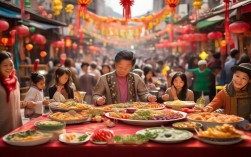The Spring Festival, known as Chinese New Year, is the most significant traditional holiday in China. Celebrated by billions worldwide, it’s a time for family reunions, cultural rituals, and joyous festivities. For English learners or anyone interested in this vibrant celebration, mastering key vocabulary can deepen understanding and appreciation. Below is a curated list of essential English words and phrases related to Chinese New Year, along with cultural insights.
Core Festive Terms
Spring Festival (春节, Chūnjié)
The official name for Chinese New Year, marking the beginning of the lunar calendar. Unlike Western New Year, it’s a 15-day celebration filled with customs.
Lunar New Year (农历新年, Nónglì Xīnnián)
A broader term acknowledging celebrations beyond China, like Vietnam’s Tết or Korea’s Seollal.
Chinese Zodiac (生肖, Shēngxiào)
Each year is associated with an animal sign (e.g., Dragon, Rabbit). 2025 is the Year of the Snake, symbolizing wisdom and adaptability.
Reunion Dinner (年夜饭, Niányèfàn)
The feast on New Year’s Eve, where families gather for dishes like fish (symbolizing abundance) and dumplings (representing wealth).
Traditional Customs & Activities
Red Envelopes (红包, Hóngbāo)
Money gifted in red packets, symbolizing luck. Called lai see in Cantonese.
Firecrackers (鞭炮, Biānpào)
Used to scare away evil spirits. Modern celebrations often use electronic alternatives for safety.

Lion Dance (舞狮, Wǔshī)
A performance by dancers in lion costumes to bring prosperity. The Dragon Dance (舞龙, Wǔlóng) is equally iconic.
Spring Couplets (春联, Chūnlián)
Poetic phrases written on red paper, hung on doors for blessings.
Lantern Festival (元宵节, Yuánxiāo Jié)
The 15th day, marking the end of celebrations with lantern displays and sweet rice balls (tangyuan).
Symbolic Foods
Dumplings (饺子, Jiǎozi)
Shaped like ancient silver coins, eaten for wealth. Making them together signifies family unity.
Nian Gao (年糕)
Sticky rice cake, symbolizing “rising prosperity” as its name sounds like “year high.”
Fish (鱼, Yú)
Served whole to represent surplus. The phrase niánnián yǒuyú means “abundance every year.”

Tangerines (橘子, Júzi)
Given as gifts because their name sounds like “luck” in Chinese.
Cultural Expressions
Guò Nián (过年)
Literally “passing the year,” referring to celebrating the New Year.
Xīnnián Kuàilè (新年快乐)
“Happy New Year” in Mandarin. Cantonese speakers say Gong Hei Fat Choy (恭喜发财), meaning “wishing you prosperity.”
Auspicious (吉祥, Jíxiáng)
A key concept; decorations and greetings often emphasize luck and good fortune.
Taboos (禁忌, Jìnjì)
Avoid sweeping on New Year’s Day (it “sweeps away” luck) or breaking objects (signifies disruption).
Modern Celebrations
Spring Festival Gala (春晚, Chūnwǎn)
An annual TV show featuring skits, music, and dances, watched by millions.

Travel Rush (春运, Chūnyùn)
The world’s largest human migration as people return home.
Digital Red Envelopes
WeChat and Alipay now allow virtual hóngbāo, blending tradition with technology.
Global Festivities
From London’s parades to NYC’s fireworks, Chinese New Year is now a worldwide phenomenon.
Understanding these terms enriches cross-cultural communication. Whether you’re teaching, traveling, or simply curious, this vocabulary bridges traditions and languages. The Spring Festival isn’t just about rituals—it’s a living culture that evolves while honoring its roots. As globalization spreads these customs, the essence remains: hope, renewal, and togetherness.
(Word count: 1,650)


